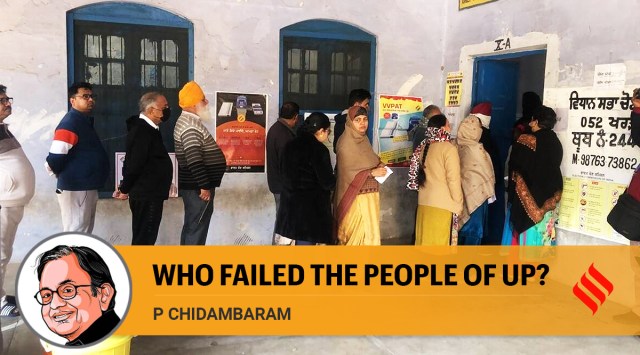
The state of Uttar Pradesh has all the attributes that could make it a political and economic success story. It has vast land (243,286 sq.km), a large population (204 million) and growing, perennial rivers (the Ganga and the Yamuna), and a hard-working people. Jawaharlal Nehru, Lal Bahadur Shastri, Indira Gandhi, Charan Singh, Rajiv Gandhi, V P Singh, Chandra Shekhar and A B Vajpayee — all Prime Ministers — were elected from UP. Yet, for many years, UP has been considered a failed state.
I must define ‘failed’ state. Let’s start with the universally accepted human development indicators. Add the numbers on GSDP growth rate, per capita income and the debt burden of the state; add the official survey data on health and education; and add the statistics on crime, unemployment and migration. If the sum total leaves a bitter taste, it is a failed state.
The Congress was last in power in UP during 1980-1989. In the last 32 years, the state has been ruled by three parties — the BJP, SP and BSP. For the good and the bad, they must take responsibility. Mr Adityanath (BJP) has been the chief minister since March 2017.
My three-point test of performance is work, welfare and wealth. Let’s apply the test to UP with the focus on macro-economic data. Under Mr Adityanath, mirroring the All-India trend, the GSDP growth rate has steadily declined:
The per capita income of UP is less than half of India’s average income. Between 2017-18 and 2020-21, the per capita income actually shrank by 1.9 per cent. During the four years, the state added 40 per cent to its debt. By March 2021, the total debt stood at a colossal Rs 6,62,891 crore which was 34.2 per cent of the GSDP. According to NITI Aayog’s Multidimensional Poverty Index report 2021, 37.9 per cent of the people of the state are poor. In 12 districts the ratio is over 50 per cent and in three districts it is 70 per cent. The conclusions stare in one’s face: UP is a poor state, its people are poor, and have become poorer under Mr Adityanath’s government.
Youth are the worst affected. The unemployment rate in UP is one of the highest in the country. Since April 2018, the unemployment rate for those aged between 15 and 29 years has been in double digits and above the All-India rate for that age group. Among women aged 15 to 29 years, the unemployment rate in July-September 2020 was 40.8 per cent. One out of four youth in urban areas was unemployed as per PLFS data for April 2018-March 2021.
The result is migration out of UP: according to the Journal of Migration Affairs, March 2020, UP had the largest number of inter-state outmigrants — 12.32 million, that is one out of 16 of the population. After the nationwide lockdown on March 25, 2020, we saw horrifying images of millions walking back to their homes, mainly in UP and Bihar.
Being a poor state that is poorly governed, the state of welfare is dismal. UP spends one of the lowest amount per capita on education. The pupil-teacher ratio is one of the highest among the states. UP needs 2,77,000 teachers to meet the shortfall. According to ASER 2021, a staggering 38.7 per cent of enrolled students were taking tuitions reflecting the failure of the school system to address their learning needs. One out of eight students drops out at Class 8. The Gross Enrolment Ratio (GER) at higher secondary level is 46.88 per cent and at the College/University level is 25.3 per cent.
The state of healthcare is no better. UP’s NMR (35.7), IMR (50.4) and under-five mortality rate (59.8) are well above the national average. The ratios of doctors (0.64), nurses (0.43) and para medics (1.38) are well below the national average. There are only 13 beds in district hospitals per 1,00,000 population. In the NITI Aayog Health Index, in four rounds ending 2019-20, U.P. ranked at the bottom.
Mr Adityanath’s model of governance is deeply flawed. He speaks loudly and carries a big stick. The model is based on a dangerous mix of authoritarianism, caste hegemony, religious hatred, police excesses and gender violence. The political vocabulary is filled with words like ‘encounter’, ‘bulldozer’ and ‘80 versus 20’. The BJP has the dubious distinction of trying to prove the hypothesis that ‘religion is the opium of the masses’.
It seems the UP election is a bi-polar fight between BJP and SP. The kind words exchanged between Mr Amit Shah and Ms Mayawati reveal the hidden plan. In a brave outreach, the Congress has pitched its flag and symbol in all 403 constituencies. Those who vote for a change, even if they succeed, may find that there is no change after the election. Alas, we may not find an answer in 2022 to the question in the title of this column.